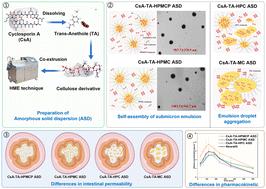Interfacial molecular engineering-driven self-emulsification: a green strategy for surfactant-free, high-efficiency oral delivery of cyclosporine A†
IF 9.2
1区 化学
Q1 CHEMISTRY, MULTIDISCIPLINARY
引用次数: 0
Abstract
We report a green chemistry strategy for oral peptide delivery using interfacial interactions to drive self-emulsification, avoiding the use of synthetic surfactants and organic solvents. By exploiting non-covalent interactions between food-grade trans-anethole (TA) and biodegradable cellulose polymers, we developed a solvent-free, hot-melt extruded system that spontaneously formed stable submicron emulsions upon contact with aqueous media. Unlike conventional self-emulsifying drug delivery systems requiring biosafety-concerning surfactants and energy-intensive processing, our design leverages renewable materials and continuous manufacturing while achieving superior performance – demonstrating 1.43-fold higher bioavailability than Neoral® in rats. Isothermal titration calorimetry tests and molecular dynamics simulations revealed how cellulose's substitution pattern precisely controlled emulsification through interfacial force modulation, enabling optimization without synthetic additives. This approach satisfies key green chemistry principles by: (1) completely avoiding organic reagents through melt processing, (2) replacing biosafety-concerning surfactants with biodegradable natural polymers, (3) reducing energy input via spontaneous emulsification, and (4) utilizing food-safe components that minimize environmental impact. The technology establishes a sustainable platform for low bioavailability drugs, combining enhanced therapeutic performance with inherently greener manufacturing.

界面分子工程驱动的自乳化:无表面活性剂、高效口服环孢素a†的绿色策略
我们报告了一种绿色化学策略,用于口服肽递送,使用界面相互作用来驱动自乳化,避免使用合成表面活性剂和有机溶剂。通过利用食品级反式anethole (TA)和可生物降解的纤维素聚合物之间的非共价相互作用,我们开发了一种无溶剂的热熔挤出系统,该系统在与水介质接触时可自发形成稳定的亚微米乳液。不像传统的自乳化给药系统需要涉及生物安全的表面活性剂和能源密集型加工,我们的设计利用了可再生材料和连续制造,同时实现了卓越的性能-在大鼠中的生物利用度比Neoral®高1.43倍。等温滴定量热测试和分子动力学模拟揭示了纤维素的取代模式如何通过界面力调节精确地控制乳化,从而在没有合成添加剂的情况下实现优化。这种方法满足了关键的绿色化学原则:(1)通过熔体加工完全避免使用有机试剂;(2)用可生物降解的天然聚合物取代涉及生物安全的表面活性剂;(3)通过自发乳化减少能量输入;(4)使用食品安全的成分,最大限度地减少对环境的影响。该技术为低生物利用度药物建立了一个可持续的平台,将增强的治疗性能与固有的绿色制造相结合。
本文章由计算机程序翻译,如有差异,请以英文原文为准。
求助全文
约1分钟内获得全文
求助全文
来源期刊

Green Chemistry
化学-化学综合
CiteScore
16.10
自引率
7.10%
发文量
677
审稿时长
1.4 months
期刊介绍:
Green Chemistry is a journal that provides a unique forum for the publication of innovative research on the development of alternative green and sustainable technologies. The scope of Green Chemistry is based on the definition proposed by Anastas and Warner (Green Chemistry: Theory and Practice, P T Anastas and J C Warner, Oxford University Press, Oxford, 1998), which defines green chemistry as the utilisation of a set of principles that reduces or eliminates the use or generation of hazardous substances in the design, manufacture and application of chemical products. Green Chemistry aims to reduce the environmental impact of the chemical enterprise by developing a technology base that is inherently non-toxic to living things and the environment. The journal welcomes submissions on all aspects of research relating to this endeavor and publishes original and significant cutting-edge research that is likely to be of wide general appeal. For a work to be published, it must present a significant advance in green chemistry, including a comparison with existing methods and a demonstration of advantages over those methods.
 求助内容:
求助内容: 应助结果提醒方式:
应助结果提醒方式:


